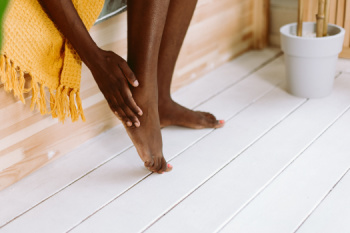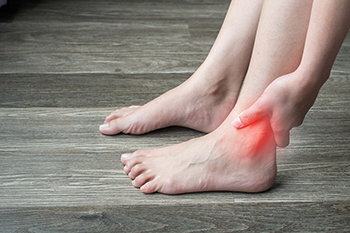Items filtered by date: June 2025
Understanding Heel Pain

Heel pain can result from plantar fasciitis, bursitis, or Achilles tendonitis. Plantar fasciitis involves inflammation of the tissue along the bottom of the foot, often causing sharp pain with the first steps in the morning. Bursitis is inflammation of the fluid-filled sacs that cushion the heel, while tendonitis affects the Achilles tendon at the back of the heel. Symptoms include stabbing or aching pain, swelling, or stiffness, especially after periods of rest or activity. The heel may feel tender to the touch or become red and warm. A podiatrist can diagnose the cause of heel pain through a physical exam, patient history, and imaging if needed. Treatment may include supportive footwear, custom orthotics, stretching exercises, or anti-inflammatory medications. If you are dealing with heel pain, it is suggested that you make an appointment with a podiatrist for evaluation and treatment.
Many people suffer from bouts of heel pain. For more information, contact one of our podiatrists of Foot and Ankle Reconstruction of Georgia. Our doctors can provide the care you need to keep you pain-free and on your feet.
Causes of Heel Pain
Heel pain is often associated with plantar fasciitis. The plantar fascia is a band of tissues that extends along the bottom of the foot. A rip or tear in this ligament can cause inflammation of the tissue.
Achilles tendonitis is another cause of heel pain. Inflammation of the Achilles tendon will cause pain from fractures and muscle tearing. Lack of flexibility is also another symptom.
Heel spurs are another cause of pain. When the tissues of the plantar fascia undergo a great deal of stress, it can lead to ligament separation from the heel bone, causing heel spurs.
Why Might Heel Pain Occur?
- Wearing ill-fitting shoes
- Wearing non-supportive shoes
- Weight change
- Excessive running
Treatments
Heel pain should be treated as soon as possible for immediate results. Keeping your feet in a stress-free environment will help. If you suffer from Achilles tendonitis or plantar fasciitis, applying ice will reduce the swelling. Stretching before an exercise like running will help the muscles. Using all these tips will help make heel pain a condition of the past.
If you have any questions, please feel free to contact our offices located in Woodstock, Jasper, and Marietta, GA . We offer the newest diagnostic and treatment technologies for all your foot care needs.
Causes and Care for Ankle Pain

Ankle pain can result from a variety of causes, ranging from sudden injury to long-term wear and tear. Sprains are among the most common sources, often caused by twisting the ankle beyond its normal range. Overuse injuries, such as tendonitis or stress on the joint, can also lead to discomfort. Arthritis, gout, and underlying structural issues like flat feet may contribute to ongoing pain or stiffness. Immediate care for ankle pain often includes rest, elevation, and avoiding activities that increase discomfort. Wearing supportive footwear and gentle stretching can help reduce stress on the joint. When pain persists, swelling increases, or walking becomes difficult, a medical evaluation is needed to rule out more serious conditions. If ankle pain is affecting your mobility or quality of life, it is suggested that you see a podiatrist for a diagnosis and care plan tailored to your needs.
Ankle pain can be caused by a number of problems and may be potentially serious. If you have ankle pain, consult with one of our podiatrists from Foot and Ankle Reconstruction of Georgia. Our doctors will assess your condition and provide you with quality foot and ankle treatment.
Ankle pain is any condition that causes pain in the ankle. Due to the fact that the ankle consists of tendons, muscles, bones, and ligaments, ankle pain can come from a number of different conditions.
Causes
The most common causes of ankle pain include:
- Types of arthritis (rheumatoid, osteoarthritis, and gout)
- Ankle sprains
- Broken ankles
- Achilles tendonitis
- Achilles tendon rupture
- Stress fractures
- Bursitis
- Tarsal tunnel syndrome
- Plantar fasciitis
Symptoms
Symptoms of ankle injury vary based upon the condition. Pain may include general pain and discomfort, swelling, aching, redness, bruising, burning or stabbing sensations, and/or loss of sensation.
Diagnosis
Due to the wide variety of potential causes of ankle pain, podiatrists will utilize a number of different methods to properly diagnose ankle pain. This can include asking for personal and family medical histories and of any recent injuries. Further diagnosis may include sensation tests, a physical examination, and potentially x-rays or other imaging tests.
Treatment
Just as the range of causes varies widely, so do treatments. Some more common treatments are rest, ice packs, keeping pressure off the foot, orthotics and braces, medication for inflammation and pain, and surgery.
If you have any questions please feel free to contact our offices located in Woodstock, Jasper, and Marietta, GA . We offer the newest diagnostic tools and technology to treat your foot and ankle needs.
Are Bunions Affecting Your Everyday Life?
How Prolonged Standing at Work Affects the Feet

Prolonged standing at work can lead to ongoing strain on the feet, toes, and ankles, especially when movement is limited. Occupations that require standing in one place for extended periods, such as retail, restaurant, or medical roles, can increase the risk of heel pain, arch fatigue, swollen feet, and joint stiffness. Standing for long periods at work causes pressure to build in the lower limbs, which can affect circulation and muscle function. Foot pain is often worsened by shoes that lack proper support and high heels, which can add extra stress to the forefoot and toes. Over time, this may contribute to the development of plantar fasciitis, bunions, or tendon inflammation. A podiatrist can assess foot structure and gait to determine how prolonged standing is affecting your feet. Treatment may include recommendations for better footwear, the use of custom orthotics to improve foot support, and, in severe cases, surgery to correct structural damage. If you have foot pain from standing at work for long periods of time, it is suggested that you schedule an appointment with a podiatrist.
While working on the feet, it is important to take the proper care of them. For more information about working on your feet, contact one of our podiatrists from Foot and Ankle Reconstruction of Georgia. Our doctors will treat your foot and ankle needs.
Working on Your Feet
Standing on your feet for long periods of time can cause stress and pain in your feet. Your whole body may experience change in terms of posture, back pain, bunions, callouses and or plantar warts. There are ways to avoid these conditions with proper foot care, smart choices and correct posture.
Positive Changes
Negative heeled shoe – Choosing this shoe type places the heel slightly lower than the ball of the foot. These are great for overall foot health. Find shoes that fit you correctly.
Go barefoot – Our feet were not designed to be enclosed for all hours of the day. Try to periodically expose your feet to air.
Eliminate Pain
Foot Exercises – Performing simple exercises, incorporating yoga and doing stretches are beneficial. This will allow increased blood flow to the area and muscles of the foot.
Achilles tendon – Stretching the foot out flat on the floor will relax the calf muscles and tendon. These exercises can be performed almost anywhere. Make sure you add these exercises to your daily regimen.
With a little bit of this information and knowing more about foot health, you will notice changes. Foot stretches and proper footwear will help with pain and prevent further issues.
If you have any questions please contact our offices located in Woodstock, Jasper, and Marietta, GA . We offer the newest diagnostic and treatment technologies for all your foot and ankle needs.
Caring for Heel Pressure Ulcers Before They Worsen

Heel pressure ulcers can develop when constant pressure reduces blood flow to the skin and tissue surrounding the heel. These wounds are more likely in people who spend long periods in bed or have reduced mobility. Early signs include redness, tenderness, or darkened skin. If not treated, the skin can break down and form deep wounds that are difficult to heal. Treatment includes relieving pressure, cleaning the area regularly, applying dressings, and using special shoes or heel protectors. Keeping the feet elevated and ensuring good nutrition can also help speed healing. Severe cases may require advanced wound care or surgery. If you notice skin changes, pain, or open sores on your heel, especially if you have diabetes or circulation issues, it is suggested that you see a podiatrist for a proper diagnosis and effective treatment.
Wound care is an important part in dealing with diabetes. If you have diabetes and a foot wound or would like more information about wound care for diabetics, consult with one of our podiatrists from Foot and Ankle Reconstruction of Georgia. Our doctors will assess your condition and provide you with quality foot and ankle treatment.
What Is Wound Care?
Wound care is the practice of taking proper care of a wound. This can range from the smallest to the largest of wounds. While everyone can benefit from proper wound care, it is much more important for diabetics. Diabetics often suffer from poor blood circulation which causes wounds to heal much slower than they would in a non-diabetic.
What Is the Importance of Wound Care?
While it may not seem apparent with small ulcers on the foot, for diabetics, any size ulcer can become infected. Diabetics often also suffer from neuropathy, or nerve loss. This means they might not even feel when they have an ulcer on their foot. If the wound becomes severely infected, amputation may be necessary. Therefore, it is of the upmost importance to properly care for any and all foot wounds.
How to Care for Wounds
The best way to care for foot wounds is to prevent them. For diabetics, this means daily inspections of the feet for any signs of abnormalities or ulcers. It is also recommended to see a podiatrist several times a year for a foot inspection. If you do have an ulcer, run the wound under water to clear dirt from the wound; then apply antibiotic ointment to the wound and cover with a bandage. Bandages should be changed daily and keeping pressure off the wound is smart. It is advised to see a podiatrist, who can keep an eye on it.
If you have any questions please contact our offices located in Woodstock, Jasper, and Marietta, GA . We offer the newest diagnostic and treatment technologies for all your foot and ankle needs.

